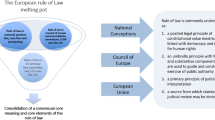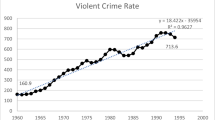Abstract
The article takes critiques of the entanglement of law with violence as a point of departure for exploring the possibility of a ‘tertium of law’. It thereby seeks to overcome the dichotomous basic assumptions that see law as always oscillating between an apology for violence on the one hand, and a utopia of reason on the other. The text analyses the possibility of this ‘tertium’, a ‘legal force’ beyond legal violence and legal reason, in four steps, drawing on the work of Jacques Derrida and authors of the first generation of the Frankfurt School, in particular on Theodor Adorno and Walter Benjamin. It argues that in a first step law needs to be dissociated from the State. The violence of law, however, does not stem solely from law’s ties with State power. Law itself is violent even where it is not State law. The second step of legal critique thus needs to consist in the commemoration of legal violence, followed by a third that demands the transformation of violence to force. These three instances of critique are the precondition for a last and essential step according to which a critique of law must facilitate the transcendence of legal violence by taking law and its promise of justice at its word in order to turn this promise against law itself.
Similar content being viewed by others
Notes
Cf. Ramshaw (2013, p. 129) referring to Derrida in writing: ‘Our only choice is that of “the lesser violence within an economy of violence”’.
See also Desmond Manderson’s description of Jimi Hendrix’s ‘The Star Spangled Banner’ at Woodstock: ‘Hendrix therefore contrasts the contemporary violence of the Vietnam War with the setting of the original anthem: the War of 1812, when the British fleet bombed Washington. So the anthem constituted the listener as a victim of the violence of war; it appealed to a courage and resourcefulness transcending that violence’ (Manderson 2014); cf. also Parker (2011, p. 962) and Manderson (2013).
References
Adorno, Theodor. 1990. Negative dialectics. London: Routledge.
Adorno, Theodor. 1991. Alban Berg: Master of the smallest link. Cambridge: Cambridge University Press.
Adorno, Theodor. 2001. Problems of moral philosophy. Cambridge: Polity Press.
Adorno, Theodor. 2002. Aesthetic theory. eds. Gretel Adorno and Rolf Tiedemann. London: Continuum.
Adorno, Theodor. 2003. Gesammelte Schriften, Band XII, Philosophie der neuen Musik. Frankfurt: Suhrkamp Verlag.
Adorno, Theodor. 2005. Education after Auschwitz. In Critical models. Interventions and Catchwords, ed. Henry W. Pickford, 191–204. New York: Columbia University Press.
Balibar, Etienne. 2009. Reflections on Gewalt. Historical Materialism 17(1): 99–125.
Benjamin, Walter. 1986a. Critique of violence. In Reflections. Essays, aphorisms, Autobiographical Writings, ed. Peter Demitz, 277–300. New York: Schocken Books.
Benjamin, Walter. 1986b. Karl Kraus. In Reflections: Essays, aphorisms, autobiographical writings, ed. Benjamin, 239–376. New York: Schocken Books.
Benjamin, Walter. 1991. Schicksal und harakter, In Gesammelte Schriften Vol 2, ed. Rolf Jiedemann, 171–179. Frankfurt: SuhrkampVerlag.
Benjamin, Walter. 2003. The origin of German tragic drama. Trans. John Osborne. London: Verso.
Bourdieu, Pierre. 1987. The force of law. Towards a sociology of the juridical field. Hastings Law Journal 38(5): 805–853.
Buckel, Sonja, and Julia König. 2012. Die Desymbolisierung des politischen Körpers. In Politische Theorie und Emotionen, ed. Felix Heidenreich and Gary S. Schaal, 217–287. Baden-Baden: Nomos.
Cohen, Hermann. 1921. Ethik des reinen Willens, 3rd ed. Berlin: Cassirer.
Deleuze, Gilles. 1998. To have done with judgment. In Essays critical and clinical, ed. Daniel W. Smith, 126–135. London: Verso.
Derrida, Jacques. 1978. Force and signification. In Writing and difference, 1–36. Chicago: University of Chicago Press.
Derrida, Jacques. 1981. Economimesis. Diacritics 11(2): 2–25.
Derrida, Jacques. 1990. Force of law: The ‘Mystical Foundation of Authority’. Cardozo Law Review 11(5): 920–1045.
Derrida, Jacques. 2002. Declarations of independence. In Negotiations. Interventions and interviews, 1971–2001, ed. Elizabeth Rottenberg, 46–54. Stanford, CA: Stanford University Press.
Derrida, Jacques. 2003. Weltbürger aller Länder, noch eine Anstrengung! [French title: Cosmopolites de tous les pays, encore un effort!] Berlin: Brinkmann und Bose.
Derrida, Jacques. 2005. Not utopia, the im-possible. In Paper machine, 121–136. Stanford, California: Stanford University Press.
Fischer-Lescano, Andreas, and Kolja Möller. 2012. Der Kampf um globale soziale Rechte. Zart wäre das Gröbste. Berlin: Wagenbach.
Früchtl, Josef. 1986. Mimesis: Konstellation eines Zentralbegriffs bei Adorno. Würzburg: Konigshausen + Neumann.
Fuchs, Peter. 2004. Wer hat wozu und wieso überhaupt Gefühle? Soziale Systeme 10(1): 89–110.
Gearey, Adam. 2001. Law and aesthetics. Oxford: Oxford University Press.
Gramsci, Antonio. 2012. Gefängnishefte. ed. Klaus Bochmann. Hamburg: Argument.
Hensel, Isabell. 2013. Klangpotentiale: Eine Annäherung an das Rauschen des Rechts. In Politische Rechtstheorie Revisited. Rudolf Wiethölter zum 100. Semester, eds. Christian Joerges and Peer Zumbansen, 61–99. ZERP Diskussionspapier 1/2013.
Jay, Martin. 1995. Mimesis und mimetologie. In Auge und Affekt, ed. Gertrud Koch, 175–201. Frankfurt am Main: Fischer.
Kant, Immanuel. 1996. Toward perpetual peace. In Practical philosophy, ed. Mary J. Gregor, 311–352. Cambridge: Cambridge University Press.
Kirchheimer, Otto. 1976/1930. Reichsgericht und Enteignung: Reichsverfassungswidrigkeit des preußischen Fluchtliniengesetzes? In Von der Weimarer Republik zum Faschismus: Die Auflösung der demokratischen Rechtsordnung, 77–90. Frankfurt am Main: Suhrkamp Verlag.
Lehmann, Hans-Thies. 1991. Theater und mythos. Stuttgart: Metzler Verlag.
Loick, Daniel. 2012. Kontingente Konnektionen: Walter Benjamins Kritik der Schuld. Deutsche Zeitschrift für Philosophie 60(5): 725–742.
Lorenzer, Alfred. 2002. Die Sprache, der Sinn, das Unbewußte. Stuttgart: Klett-Cotta.
Manderson, Desmond. 2014. Towards law and music. Law and Critique 25(3): 311–317.
Manderson, Desmond. 2013. Making a point and making a noise: A punk prayer. Law, Culture and the Humanities (made available online June 2013: forthcoming): 1–15.
Maroney, Terry A. 2006. Law and emotion: A proposed taxonomy of an emerging field. Law and Human Behavior 30(2): 119–142.
Marx, Karl. 2000a. On the Jewish Question. In Selected writings, ed. David McLellan, 46–70. Oxford: Oxford University Press.
Marx, Karl. 2000b. Critique of Hegel’s ‘Philosophy of Right’. In Selected writings, ed. David McLellan, 32–42. Oxford: Oxford University Press.
Menke, Christoph. 2005. Die Gegenwart der Tragödie: Versuch über Urteil und Spiel. Frankfurt: Suhrkamp.
Menke, Christoph. 2013. Force. A fundamental concept of aesthetic anthropology. New York: Fordham University Press.
Philippopoulos-Mihalopoulos, Andreas. 2013. Atmospheres of law: Senses, affects, lawscapes. Emotion, Space and Society 7: 35–44.
Müller, Heiner. 1998. Werke. Die Gedichte, ed. Frank Hörnigk. Frankfurt am Main: Suhrkamp Verlag.
Neumann, Franz. 1986. The rule of law: Political theory and the legal system in modern society. Leamington Spa: Berg.
Nietzsche, Friedrich. 2007. The dawn of day. Mineola, NY: Dover Publications.
Noeth, Bryan, and Rajdeep Sengupta. 2012. Global European banks and the financial crisis. Federal Reserve Bank of St. Louis Review 94(6): 457–479.
Opitz, Sven. 2012. Gibt es einen normativen Eigensinn der (R)Evolution? Soziale Welt 63(3): 283–292.
Oxfam. 2012. Mit Essen spielt man nicht! Die deutsche Finanzbranche und das Geschäft mit dem Hunger. NGO Report.
Parker, James. 2011. The soundscape of justice. Griffith Law Review 20(4): 962–993.
Poulantzas, Nicos. 2002. Staatstheorie: politischer Überbau, Ideologie, sozialistische Demokratie. Hamburg: VSA Verlag.
Ramshaw, Sara. 2013. Justice as improvisation. The law of the extempore. Oxford: Routledge.
Rosenzweig, Franz. 1920. Hegel und der Staat. Frankfurt am Main: Suhrkamp. Reprint 2010.
Sagnol, Marc. 1995. Recht und Gerechtigkeit bei Walter Benjamin. In Die Gegenwart der Gerechtigkeitt. Diskurse zwischen Recht, praktischer Philosophie und Politik, ed. Christoph Demmerlingand and Thomas Rentsch, 57–65. Berlin: AkademieVerlag.
Schiller, Friedrich. 1980. The robbers and Wallenstein. London: Penguin.
Smith, Helena. 2011. Greek woes drive up suicide rate. The Guardian (18 December 2011).
Spivak, Gayatri Chakravorty. 1996. Diasporas old and new: Women in the transnational world. Textual Practice 10(2): 245–269.
Teubner, Gunther. 2009. Self-subversive justice: Contingency or transcendence formula of law? Modern Law Review 72(1): 1–23.
Teubner, Gunther. 2012. Verfassungsfragmente—Gesellschaftlicher Konstitutionalismus in der Globalisierung. Frankfurt: Suhrkamp.
Weber, Max. 1988. Gesammelte Aufsätze zur Wissenschaftslehre. München: J.C.B. Mohr.
Wiethölter, Rudolf. 1989. Ist unserem Recht der Prozeß zu machen? In Zwischenbetrachtungen im Prozeß der Aufklärung. Jürgen Habermas zum 60. Geburtstag, ed. Axel Honneth, 794–812. Frankfurt: Suhrkamp Verlag.
Wischke, Mirko. 1995. Eine negativ gewendete Ethik des richtigen Lebens? In Impuls und Negativität. Ethik und Ästhetik bei Adorno, ed. Gerhard Schweppenhäuser and Mirko Wischke, 29–43. Hamburg: Argument.
Zimmermann, Norbert. 1989. Der ästhetische Augenblick. Frankfurt: Peter Lang.
Author information
Authors and Affiliations
Rights and permissions
About this article
Cite this article
Fischer-Lescano, A. A ‘Just and Non-violent Force’? Critique of Law in World Society. Law Critique 26, 267–280 (2015). https://doi.org/10.1007/s10978-015-9164-x
Published:
Issue Date:
DOI: https://doi.org/10.1007/s10978-015-9164-x




